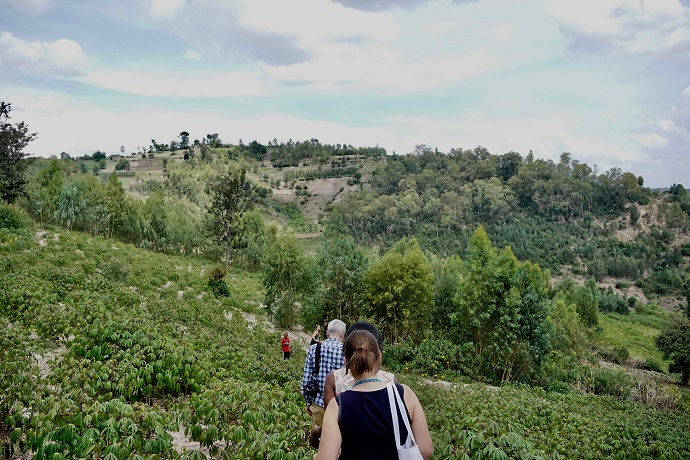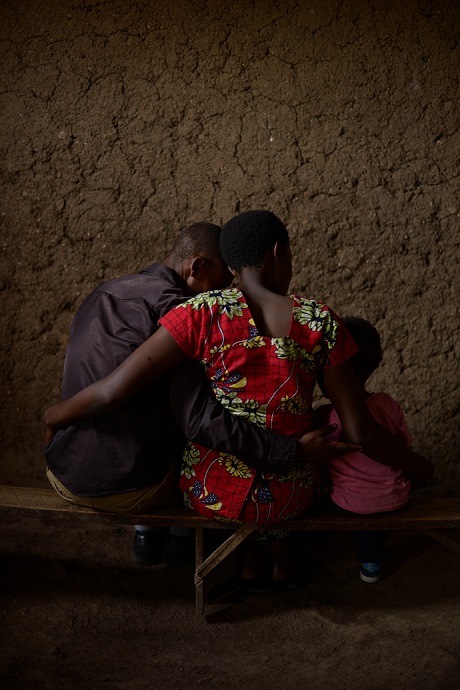Secondary menu
"And I Live On": Shining Light on Rwandan Genocide Survivors' Resilience
On the evening of April 1, I am sitting in the chapel at the University of Toronto’s Hart House, listening to a loop of beautiful sounds. Birds chirping. A sonorous choir. In between, soft voices speak in Kinyarwanda and are translated into English.
I have heard these sounds once before, months ago, in Rwanda. In November 2018, I, joined IHRP Director Samer Muscati, IHRP clinic student India Annamanthadoo (2L), and Anne-Marie de Brouwer and Eefje de Volder from our Dutch partner IMPACT, in Kigali to interview survivors of the Rwandan genocide, just before the 25th annual commemoration of the atrocities. Ten years ago, Anne-Marie, Samer, and Sandra Ka Hon Chu helped immortalize the survivors’ accounts of violence in a book entitled The Men Who Killed Me. This time, we hoped to turn the world’s attention to a different side of their stories. And I Live On: The Resilience of Rwandan Genocide Survivors of Sexual Violence focuses on the survivors’ perseverance and healing journeys in the decade since the writing of the first book. The book was released on April 1, accompanied by a photography and audio exhibit in the Talking Walls Exhibition Space at Hart House.
My most vivid memory of Rwanda takes place on a mountain in the country’s south. I remember panting under the weight of the sun, painfully focused on placing one foot in front of the other lest I lose face before the nine-year-old girl prancing up the slope ahead. Behind me, her father Faustin watched carefully to ensure that his guests – myself and the rest of our team – did not fall. He had just finished leading us on a half-hour trek to see his cassava fields, where he had stood proudly in the middle of a plot as Samer snapped photos. At one point Faustin disappeared from view. When he re-emerged, his slight silhouette was overwhelmed by two massive and freshly harvested cassava roots on each shoulder – gifts for his visitors, to accompany the generous portions of homegrown peanuts that each of his children placed in our hands before we left. For their part, Anne-Marie and Eefje handed him a bolt of brightly patterned cloth. “For your wedding,” Anne-Marie said.

The IHRP and IMPACT team making their way to Faustin's cassava field. One of the less treacherous parts of the hike. Photography by Yolanda Song.
Faustin is a survivor of the Rwandan genocide, and one of the hundreds of thousands of people who suffered sexual violence during the conflict. Ten years ago, he told Anne-Marie and Sandra that, in the years after the genocide, he hated himself for a long time. “I hated my life and wanted it to end.” At the time, he struggled with living and being alone. Nearly all his loved ones had been killed.
In Hart House, I hear Faustin’s soft voice enter the chapel. He says that, for survivors, the way forward lies in hard work, self-love, and love for others – “we survived for that reason.” After his family was destroyed in the genocide, it was at a gathering of survivors that he fell in love with the woman who became his wife, and with whom he is now raising five beautiful children.

Faustin with his wife and youngest child in their home. Photography by Samer Muscati.
Of course, none of those we interviewed said that healing has been easy. Each of them still bears the deep physical and psychological scars of the atrocities inflicted upon them – “probably the worst I’ve heard in my career [of documenting international crimes],” Samer said. I remember sitting in my room in Rwanda transcribing a recorded interview that my colleagues conducted with a woman named Pascasie. I had met Pascasie only briefly after her interview, when she posed happily – even insistently – for a photo with India and me. In the recording, though, her voice was heavy with sadness. “I don’t think we shall ever forget about what happened; it will always come back. This is the life we must accept to live. We cannot forget; we just pretend not to remember.”
Like too many others, Pascasie lost her entire family in 1994, including her husband and young child. She suffered unimaginable horrors. She told my colleagues, “After what happened during the genocide, I felt like I could never love another man. Otherwise, I would have remarried and had children.” She lives with two orphans, now young adults, but their relationship is complicated and strained. “Their love for me is not the same as the love I have for them,” she said.
But Pascasie does not feel alone. In the recording, she talked about Solace Ministries, a Rwandan organization that provides services to genocide survivors, and our home base in Kigali. “I call this my family,” she said.
When Pascasie began to cry, they took a break from the interview, but the recording continued. There was the crinkling of plastic as one of the women passed around a bag of cookies. Then I heard Anne-Marie and Eefje start to sing a simple hymn they learned in Rwanda, from a Solace Ministries counsellor. Pascasie and their translator, Christine, joined in. I thought I heard India humming along. The Dutch women forgot the rest of the lyrics, and everyone laughed.
In And I Live On, the editors write: “So often, narratives of genocide are limited to the violence that was inflicted over a deadly, discrete period.” As human rights advocates, we have an undeniable role in shaping this narrative. Our power as interviewers, editors, and retellers of survivors’ stories is immense. By shining light on their incredible resilience and strength, I hope this book can contribute to a different dimension of the narrative of the Rwandan conflict, one that honours survivors’ desires to have their full stories told. Many of the individuals we interviewed expressed their wish to serve as examples for other survivors of violence, in Rwanda and around the world.
I hear the hymn again in Hart House. When it ends, Pascasie’s low, regal voice speaks. She says, “I want to show those people who did wrong to me that what they thought of me is not what is happening now.”
--
And I Live On: The Resilience of Rwandan Genocide Survivors of Sexual Violence is available at the Faculty of Law bookstore. The photography exhibit is featured as part of the 2019 Scotiabank CONTACT Photography Festival and will be on display at Hart House until May 31, 2019.
Read reflections on this project by our students Mehak Kawatra and India Annamanthadoo.
